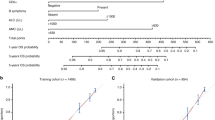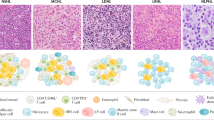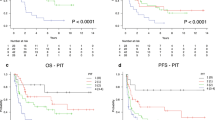Abstract
Despite the use of modern immunochemotherapy regimens, almost 50% of patients with diffuse large-B-cell lymphoma will relapse. Current prognostic models, including the International Prognostic Index, incorporate patient and tumor characteristics. In contrast, recent observations show that variables related to host adaptive immunity and the tumor microenvironment are significant prognostic variables in non-Hodgkin lymphoma. Therefore, we retrospectively examined the absolute monocyte and lymphocyte counts as prognostic variables in a cohort of 366 diffuse large-B-cell lymphoma patients who were treated between 1993 and 2007 and followed at a single institution. The absolute monocyte and lymphocyte counts in univariate analysis predicted progression-free and overall survival when analyzed as continuous and dichotomized variables. On multivariate analysis performed with factors included in the IPI, the absolute monocyte and lymphocyte counts remained independent predictors of progression-free and overall survival. Therefore, the absolute monocyte and lymphocyte counts were combined to generate a prognostic score that identified patients with an especially poor overall survival. This prognostic score was independent of the IPI and added to its ability to identify high-risk patients.
This is a preview of subscription content, access via your institution
Access options
Subscribe to this journal
Receive 12 print issues and online access
$259.00 per year
only $21.58 per issue
Buy this article
- Purchase on Springer Link
- Instant access to full article PDF
Prices may be subject to local taxes which are calculated during checkout





Similar content being viewed by others
References
Sehn LH, Berry B, Chhanabhai M, Fitzgerald C, Gill K, Hoskins P et al. The revised International Prognostic Index (R-IPI) is a better predictor of outcome than the standard IPI for patients with diffuse large B-cell lymphoma treated with R-CHOP. Blood 2007; 109: 1857–1861.
Ziepert M, Hasenclever D, Kuhnt E, Glass B, Schmitz N, Pfreundschuh M et al. Standard International Prognostic Index remains a valid predictor of outcome for patients with aggressive CD20+ B-cell lymphoma in the rituximab era. J Clin Oncol 2010; 28: 2373–2380.
Lenz G, Wright G, Dave SS, Xiao W, Powell J, Zhao H et al. Stromal gene signatures in large-B-cell lymphomas. N Engl J Med 2008; 359: 2313–2323.
Alizadeh AA, Eisen MB, Davis RE, Ma C, Lossos IS, Rosenwald A et al. Distinct types of diffuse large B-cell lymphoma identified by gene expression profiling. Nature 2000; 403: 503–511.
Lossos IS, Czerwinski DK, Alizadeh AA, Wechser MA, Tibshirani R, Botstein D et al. Prediction of survival in diffuse large-B-cell lymphoma based on the expression of six genes. N Engl J Med 2004; 350: 1828–1837.
Rosenwald A, Wright G, Chan WC, Connors JM, Campo E, Fisher RI et al. The use of molecular profiling to predict survival after chemotherapy for diffuse large-B-cell lymphoma. N Engl J Med 2002; 346: 1937–1947.
Shipp MA, Ross KN, Tamayo P, Weng AP, Kutok JL, Aguiar RC et al. Diffuse large B-cell lymphoma outcome prediction by gene-expression profiling and supervised machine learning. Nat Med 2002; 8: 68–74.
Hermine O, Haioun C, Lepage E, d'Agay MF, Briere J, Lavignac C et al. Prognostic significance of bcl-2 protein expression in aggressive non-Hodgkin's lymphoma. Groupe d'Etude des Lymphomes de l'Adulte (GELA). Blood 1996; 87: 265–272.
Mounier N, Briere J, Gisselbrecht C, Emile JF, Lederlin P, Sebban C et al. Rituximab plus CHOP (R-CHOP) overcomes bcl-2-associated resistance to chemotherapy in elderly patients with diffuse large B-cell lymphoma (DLBCL). Blood 2003; 101: 4279–4284.
Ansell SM, Stenson M, Habermann TM, Jelinek DF, Witzig TE . Cd4+ T-cell immune response to large B-cell non-Hodgkin's lymphoma predicts patient outcome. J Clin Oncol 2001; 19: 720–726.
Tzankov A, Meier C, Hirschmann P, Went P, Pileri SA, Dirnhofer S . Correlation of high numbers of intratumoral FOXP3+ regulatory T cells with improved survival in germinal center-like diffuse large B-cell lymphoma, follicular lymphoma and classical Hodgkin's lymphoma. Haematologica 2008; 93: 193–200.
Lee NR, Song EK, Jang KY, Choi HN, Moon WS, Kwon K et al. Prognostic impact of tumor infiltrating FOXP3 positive regulatory T cells in diffuse large B-cell lymphoma at diagnosis. Leuk Lymph 2008; 49: 247–256.
Hasselblom S, Sigurdadottir M, Hansson U, Nilsson-Ehle H, Ridell B, Andersson PO . The number of tumour-infiltrating TIA-1+ cytotoxic T cells but not FOXP3+ regulatory T cells predicts outcome in diffuse large B-cell lymphoma. Br J Haematol 2007; 137: 364–373.
Hans CP, Weisenburger DD, Greiner TC, Gascoyne RD, Delabie J, Ott G et al. Confirmation of the molecular classification of diffuse large B-cell lymphoma by immunohistochemistry using a tissue microarray. Blood 2004; 103: 275–282.
Nyman H, Jerkeman M, Karjalainen-Lindsberg ML, Banham AH, Leppa S . Prognostic impact of activated B-cell focused classification in diffuse large B-cell lymphoma patients treated with R-CHOP. Mod Pathol 2009; 22: 1094–1101.
Nyman H, Adde M, Karjalainen-Lindsberg ML, Taskinen M, Berglund M, Amini RM et al. Prognostic impact of immunohistochemically defined germinal center phenotype in diffuse large B-cell lymphoma patients treated with immunochemotherapy. Blood 2007; 109: 4930–4935.
Mikhaeel NG . Interim fluorodeoxyglucose positron emission tomography for early response assessment in diffuse large B cell lymphoma: where are we now? Leuk Lymph 2009; 50: 1931–1936.
Duhrsen U, Huttmann A, Jockel KH, Muller S . Positron emission tomography guided therapy of aggressive non-Hodgkin lymphomas—the PETAL trial. Leuk Lymph 2009; 50: 1757–1760.
Dave SS, Wright G, Tan B, Rosenwald A, Gascoyne RD, Chan WC et al. Prediction of survival in follicular lymphoma based on molecular features of tumor-infiltrating immune cells. N Engl J Med 2004; 351: 2159–2169.
Oki Y, Yamamoto K, Kato H, Kuwatsuka Y, Taji H, Kagami Y et al. Low absolute lymphocyte count is a poor prognostic marker in patients with diffuse large B-cell lymphoma and suggests patients' survival benefit from rituximab. Eur J Haematol 2008; 81: 448–453.
Behl D, Ristow K, Markovic SN, Witzig TE, Habermann TM, Colgan JP et al. Absolute lymphocyte count predicts therapeutic efficacy of rituximab therapy in follicular lymphomas. Br J Haematol 2007; 137: 409–415.
Cox MC, Nofroni I, Laverde G, Ferrari A, Amodeo R, Tatarelli C et al. Absolute lymphocyte count is a prognostic factor in diffuse large B-cell lymphoma. Br J Haematol 2008; 141: 265–268.
Kim DH, Baek JH, Chae YS, Kim YK, Kim HJ, Park YH et al. Absolute lymphocyte counts predicts response to chemotherapy and survival in diffuse large B-cell lymphoma. Leukemia 2007; 21: 2227–2230.
Fruehauf S, Tricot G . Comparison of unmobilized and mobilized graft characteristics and the implications of cell subsets on autologous and allogeneic transplantation outcomes. Biol Blood Marrow Transplant 2010; 16: 1629–1648.
Shivakumar L, Ansell S . Targeting B-lymphocyte stimulator/B-cell activating factor and a proliferation-inducing ligand in hematologic malignancies. Clin Lymph Myel 2006; 7: 106–108.
Wilcox RA, Wada DA, Ziesmer SC, Elsawa SF, Comfere NI, Dietz AB et al. Monocytes promote tumor cell survival in T-cell lymphoproliferative disorders and are impaired in their ability to differentiate into mature dendritic cells. Blood 2009; 114: 2936–2944.
Cox CJ, Habermann TM, Payne BA, Klee GG, Pierre RV . Evaluation of the Coulter Counter model S-Plus IV. Am J Clin Pathol 1985; 84: 297–306.
Anonymous . A predictive model for aggressive non-Hodgkin's lymphoma. The International Non-Hodgkin's Lymphoma Prognostic Factors Project. N Engl J Med 1993; 329: 987–994.
Kaplan EL, Meier P . Nonparametric estimation from incomplete observations. J Am Stat Assoc 1958; 53: 457–481.
Cheson BD, Pfistner B, Juweid ME, Gascoyne RD, Specht L, Horning SJ et al. Revised response criteria for malignant lymphoma. J Clin Oncol 2007; 25: 579–586.
Song MK, Chung JS, Seol YM, Kim SG, Shin HJ, Choi YJ et al. Influence of low absolute lymphocyte count of patients with nongerminal center type diffuse large B-cell lymphoma with R-CHOP therapy. Ann Oncol 2010; 21: 140–144.
Porrata LF, Inwards DJ, Ansell SM, Micallef IN, Johnston PB, Hogan WJ et al. New-onset lymphopenia assessed during routine follow-up is a risk factor for relapse postautologous peripheral blood hematopoietic stem cell transplantation in patients with diffuse large B-cell lymphoma. Biol Blood Marrow Transplant 2010; 16: 376–383.
Cox DR . Regression models and life tablets. J R Statist Soc Ser C 1972; 34: 187–202.
Ansell SM, Stenson M, Habermann TM, Jelinek DF, Witzig TE . Cd4+ T-cell immune response to large B-cell non-Hodgkin's lymphoma predicts patient outcome. J Clin Oncol 2001; 19: 720–726.
Young MR, Newby M, Wepsic HT . Hematopoiesis and suppressor bone marrow cells in mice bearing large metastatic Lewis lung carcinoma tumors. Cancer Res 1987; 47: 100–105.
Young MR, Ellis NK, Young ME, Wepsic HT . Stimulation of hematopoiesis and bone marrow suppressor cells by the subcutaneous injection of linoleic acid. Cell Immunol 1987; 107: 238–248.
Gabrilovich DI, Nagaraj S . Myeloid-derived suppressor cells as regulators of the immune system. Nat Rev Immunol 2009; 9: 162–174.
Seung LP, Rowley DA, Dubey P, Schreiber H . Synergy between T-cell immunity and inhibition of paracrine stimulation causes tumor rejection. Proc Natl Acad Sci USA 1995; 92: 6254–6258.
Mandrekar SJ, Schild SE, Hillman SL, Allen KL, Marks RS, Mailliard JA et al. A prognostic model for advanced stage nonsmall cell lung cancer. Pooled analysis of North Central Cancer Treatment Group trials. Cancer 2006; 107: 781–792.
Schmidt H, Bastholt L, Geertsen P, Christensen IJ, Larsen S, Gehl J et al. Elevated neutrophil and monocyte counts in peripheral blood are associated with poor survival in patients with metastatic melanoma: a prognostic model. Br J Cancer 2005; 93: 273–278.
Schmidt H, Suciu S, Punt CJ, Gore M, Kruit W, Patel P et al. Pretreatment levels of peripheral neutrophils and leukocytes as independent predictors of overall survival in patients with American Joint Committee on Cancer Stage IV Melanoma: results of the EORTC 18951 Biochemotherapy Trial. J Clin Oncol 2007; 25: 1562–1569.
Michael M, Goldstein D, Clarke SJ, Milner AD, Beale P, Friedlander M et al. Prognostic factors predictive of response and survival to a modified FOLFOX regimen: importance of an increased neutrophil count. Clin Colorectal Cancer 2006; 6: 297–304.
Choueiri TK, Garcia JA, Elson P, Khasawneh M, Usman S, Golshayan AR et al. Clinical factors associated with outcome in patients with metastatic clear-cell renal cell carcinoma treated with vascular endothelial growth factor-targeted therapy. Cancer 2007; 110: 543–550.
Donskov F, von der Maase H . Impact of immune parameters on long-term survival in metastatic renal cell carcinoma. J Clin Oncol 2006; 24: 1997–2005.
Paesmans M, Sculier JP, Lecomte J, Thiriaux J, Libert P, Sergysels R et al. Prognostic factors for patients with small cell lung carcinoma: analysis of a series of 763 patients included in 4 consecutive prospective trials with a minimum follow-up of 5 years. Cancer 2000; 89: 523–533.
Takasaki Y, Iwanaga M, Tsukasaki K, Kusano M, Sugahara K, Yamada Y et al. Impact of visceral involvements and blood cell count abnormalities on survival in adult T-cell leukemia/lymphoma (ATLL). Leuk Res 2007; 31: 751–757.
Wilcox RA, Feldman AL, Wada DA, Yang ZZ, Comfere NI, Dong H et al. B7-H1 (PD-L1, CD274) suppresses host immunity in T-cell lymphoproliferative disorders. Blood 2009; 114: 2149–2158.
Wilcox RA . Cancer-associated myeloproliferation: old association, new therapeutic target. Mayo Clin Proc 2010; 85: 656–663.
De Palma M, Venneri MA, Galli R, Sergi Sergi L, Politi LS, Sampaolesi M et al. Tie2 identifies a hematopoietic lineage of proangiogenic monocytes required for tumor vessel formation and a mesenchymal population of pericyte progenitors. Cancer Cell 2005; 8: 211–226.
Venneri MA, De Palma M, Ponzoni M, Pucci F, Scielzo C, Zonari E et al. Identification of proangiogenic TIE2-expressing monocytes (TEMs) in human peripheral blood and cancer. Blood 2007; 109: 5276–5285.
He B, Chadburn A, Jou E, Schattner EJ, Knowles DM, Cerutti A . Lymphoma B cells evade apoptosis through the TNF family members BAFF/BLyS and APRIL. J Immunol 2004; 172: 3268–3279.
Novak AJ, Grote DM, Stenson M, Ziesmer SC, Witzig TE, Habermann TM et al. Expression of BLyS and its receptors in B-cell non-Hodgkin lymphoma: correlation with disease activity and patient outcome. Blood 2004; 104: 2247–2253.
Oki Y, Georgakis GV, Migone TS, Kwak LW, Younes A . Elevated serum BLyS levels in patients with non-Hodgkin lymphoma. Leuk Lymph 2007; 48: 1869–1871.
Seiffert M, Schulz A, Ohl S, Dohner H, Stilgenbauer S, Lichter P . Soluble CD14 is a novel monocyte-derived survival factor for chronic lymphocytic leukemia cells, which is induced by CLL cells in vitro and present at abnormally high levels in vivo. Blood 2010; 116: 4223–4230.
Porrata LF, Markovic SN . Timely reconstitution of immune competence affects clinical outcome following autologous stem cell transplantation. Clin Exp Med 2004; 4: 78–85.
Weiner GJ . Rituximab: mechanism of action. Semin Hematol 2010; 47: 115–123.
Ko JS, Bukowski RM, Fincke JH . Myeloid-derived suppressor cells: a novel therapeutic target. Curr Oncol Rep 2009; 11: 87–93.
Author information
Authors and Affiliations
Corresponding author
Ethics declarations
Competing interests
The authors declare no conflict of interest.
Additional information
Author contributions
RAW designed study, performed research, analyzed data and wrote the manuscript; KR performed research, provided technical assistance and reviewed the manuscript; TMH, DJI, INMM, PBJ, JPC, GSN, SMA, TEW and SNM assisted with data analysis and manuscript preparation; LP assisted with study design, data analysis and manuscript preparation.
Rights and permissions
About this article
Cite this article
Wilcox, R., Ristow, K., Habermann, T. et al. The absolute monocyte and lymphocyte prognostic score predicts survival and identifies high-risk patients in diffuse large-B-cell lymphoma. Leukemia 25, 1502–1509 (2011). https://doi.org/10.1038/leu.2011.112
Received:
Revised:
Accepted:
Published:
Issue Date:
DOI: https://doi.org/10.1038/leu.2011.112
Keywords
This article is cited by
-
Development and validation of a novel risk stratification model and a survival rate calculator for diffuse large B-cell lymphoma in the rituximab era: a multi-institutional cohort study
Annals of Hematology (2024)
-
Enhancement of the International prognostic index with β2-microglobulin, platelet count and red blood cell distribution width: a new prognostic model for diffuse large B-cell lymphoma in the rituximab era
BMC Cancer (2022)
-
Serum Estrogen and its Soluble Receptor Levels in Egyptian Patients with Chronic Myeloid Leukemia: A Case–Control Study
Indian Journal of Hematology and Blood Transfusion (2022)
-
Polatuzumab vedotin–based salvage immunochemotherapy as third-line or beyond treatment for patients with diffuse large B-cell lymphoma: a real-world experience
Annals of Hematology (2022)
-
The value of a new prognostic model developed by lymphocyte-monocyte ratio and platelet-monocyte ratio in peripheral T-cell lymphoma
Cancer Cell International (2021)



